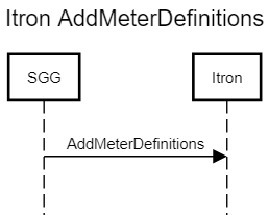Example: Itron Commissioning Process
This section provides an example of a synchronous command, the commission device command supported by the Itron OpenWay adapter.
The Itron OpenWay 3.9 command for registering a meter (commissioning a device) in the system is AddMeterDefinitions in the www.itron.com.ami.2008.10.provisioning.wsdl definition. The Smart Grid Gateway Adapter for Itron OpenWay typically sends a meter serial number and some other configuration data. The response indicates whether or not an error was encountered.
The image below illustrates the process flow used by this command.

Below is a summary of the important features of the Smart Grid Gateway implementation of this command. Many of the concepts can be applied when creating a custom synchronous command.
Command Activity — Device Commissioning
Business Object: D1-DeviceCommissioning
Lifecycle and Algorithms
The table below outlines some of the important algorithms used by the Device Commissioning command activity.
| Lifecycle State | Algorithms |
|---|---|
|
Validate |
The important features here are not the specific algorithms, but rather the ability to perform validation logic at a process level.
|
|
Commission Ready |
Several algorithms in this state are designed to create outbound communications to the head end system based on various conditions.
|
|
Communication In Progress |
|
|
Execute Completion Events |
|
Outbound Communication — Itron - Add Meter Definition (Commission)
Business Object: D8-AddMeterDefinitionsDR
Schema
The portions of the schema that contain the payload of the web service request and response communications are the sendDetail element (constructed using the D8-AddMeterDefinitionsDRDA data area) and the responseDetail element (constructed using the D8-AddMeterDefRespDRDA data area). The XSLs used to create or decipher XML conforming to the Itron structure use these elements as a basis.
Lifecycle and Algorithms
The table below outlines some of the important algorithms used by the Add Meter Definition outbound communication.
| Lifecycle State | Algorithms |
|---|---|
|
Validate |
|
|
Awaiting Response |
|
|
Response Error |
The business object will transition to this state if the reply indicates a failure.
|
|
Create Completion Event |
|
|
Completed |
|
Message Sender XSLs
Outbound messages created by Add Meter Definition outbound communication use the following XSL files:
- Request XSL: D8-CommissionRequest.xsl
- Response XSL: D8-CommissionResponse.xsl
Refer to Creating Message Senders for more information about creating message senders.
